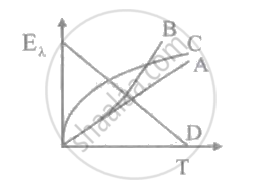Advertisements
Advertisements
Question
Explain the spectral distribution of blackbody radiation.
Solution 1
All objects with a temperature above absolute zero (0 K, -273.15oC) emit energy in the form of electromagnetic radiation.
A blackbody is a theoretical or model body that absorbs all radiation falling on it, reflecting or transmitting none. It is a hypothetical object which is a “perfect” absorber and a “perfect” emitter of radiation over all wavelengths.
The spectral distribution of the thermal energy radiated by a blackbody (i.e. the pattern of the intensity of the radiation over a range of wavelengths or frequencies) depends only on its temperature.

The characteristics of blackbody radiation can be described in terms of several laws:
- Planck’s Law of blackbody radiation, a formula to determine the spectral energy density of the emission at each wavelength (Eλ) at a particular absolute temperature (T).
`"E"_λ = (8pi"h c")/(λ^5 ("e"^("hc"//λ"kT")-1))` - Wien’s Displacement Law, which states that the frequency of the peak of the emission (fmax) increases linearly with absolute temperature (T). Conversely, as the temperature of the body increases, the wavelength at the emission peak decreases.
fmax α T - Stefan–Boltzmann Law, which relates the total energy emitted (E) to the absolute temperature (T).
E α T4
In the image above, notice that:
- The blackbody radiation curves have quite a complex shape (described by Planck’s Law).
- The spectral profile (or curve) at a specific temperature corresponds to a specific peak wavelength, and vice versa.
- As the temperature of the blackbody increases, the peak wavelength decreases (Wien’s Law).
- The intensity (or flux) at all wavelengths increases as the temperature of the blackbody increases.
- The total energy being radiated (the area under the curve) increases rapidly as the temperature increases (Stefan–Boltzmann Law).
- Although the intensity may be very low at very short or long wavelengths, at any temperature above absolute zero energy is theoretically emitted at all wavelengths (the blackbody radiation curves never reach zero).
Solution 2
- The rate of emission per unit area or power per unit area of a surface is defined as a function of the wavelength λ of the emitted radiation.
- Scientists studied the energy distribution of blackbody radiation as a function of wavelength.

- By keeping the source of radiation (such as a cavity radiator) at different temperatures they measured the radiant power corresponding to different wavelengths. The measurements were represented graphically in the form of curves showing the variation of radiant power per unit area as a function of wavelength λ at different constant temperatures as shown in the figure.
APPEARS IN
RELATED QUESTIONS
State the Wien's displacement law
Two spherical black bodies of radius r1 and r2 with surface temperature T1 and T2 respectively, radiate same power, then r1 : r2 is ______.
The radiation energy density per unit wavelength at a temperature T has a maximum at a wavelength `lambda_0.` At temperature 4T, it will have a maximum at a wavelength ____________.
A blackbody is at a temperature of 5760 K. The energy of radiation emitted by the body at wavelength 250 nm is U1, at wavelength 500 nm is U2 and that at 1000 nm is U3. Wien's constant, b = 2.88 x 106 nmK. Which of the following is correct?
At a fixed wavelength, the `"E"_lambda` - T graph for an ideal blackbody is ____________.

The colour of a star depends upon its ____________.
About black body radiation, which one of the following is 'WRONG' statement?
Out of the following which statement is NOT true about black body radiation?
What is the temperature at which a blackbody radiates heat at the rate of 1 kilowatt per square metre?
Explain Planck's idea of the quantization of energy.
Draw a neat labelled diagram of Radiant power of a blackbody per unit range of wavelength as a function of wavelength.
Assuming that the temperature at the surface of the sun is 6000 K, find out the size of a virtual star (in terms of the size of the sun) whose surface termperature is 3000 K and the power radiated by the virtual star is 25 times the power radiated by the sun. Treat both the sun and virtual star as a blackbody.
